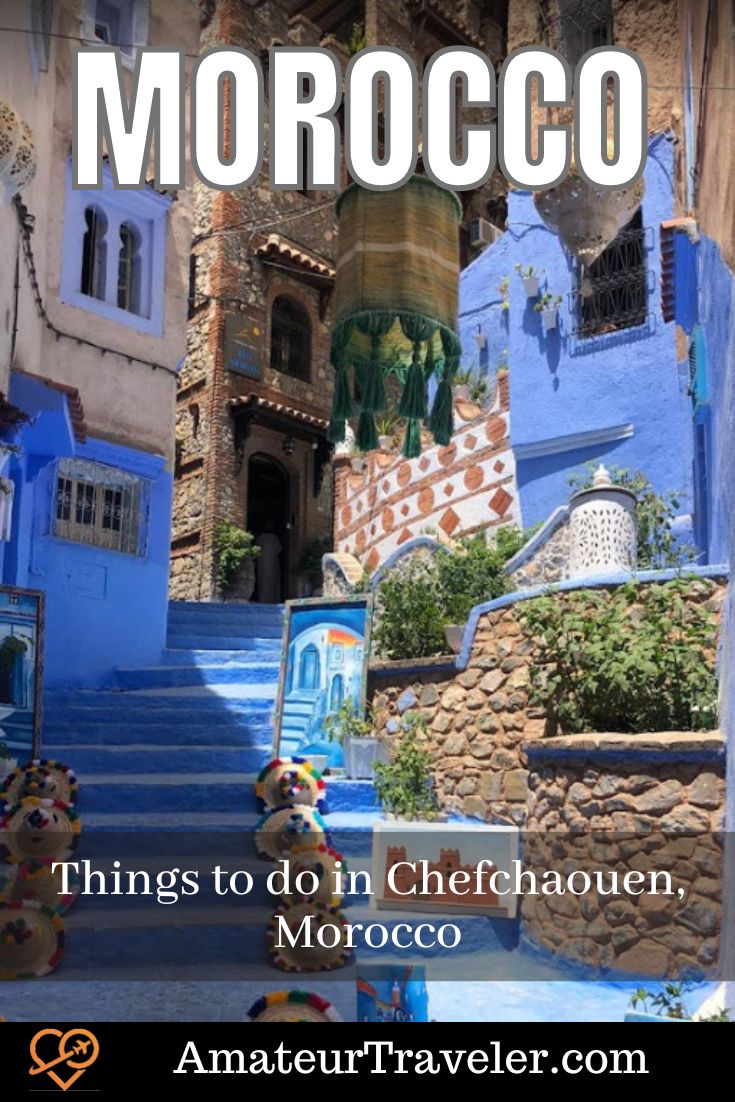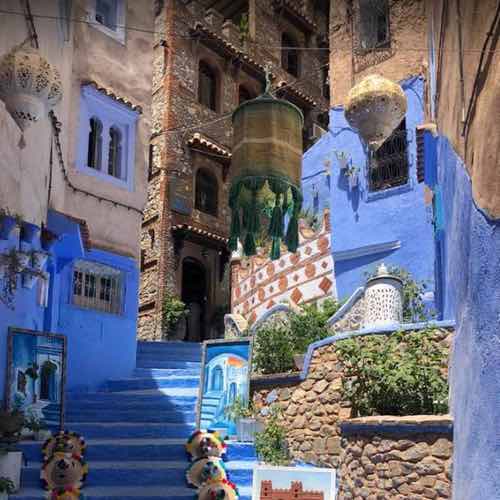Things to do in Chefchaouen, Morocco

When I was a kid, my parents used to take me to Chefchaouen regularly. Decades later, whenever I visit Morocco, I make sure to include Chefchaouen in my trip. Located in northeast Morocco in the Rif mountains, Chefchaouen – also known as the blue city – is a charming city filled with blue-tinted homes, colorful flower pots, and charming narrow streets. A unique spectacle for sure. But there is more to be found in the city.
Chefchaouen was not always painted its famous color of blue. There are different stories about how the blue came about, but one of the best-known ones is that a large number of European Jews fled Europe in the 1930s and settled in Chefchaouen. They started painting their buildings blue, representative of the sky. Slowly the color spread to more and more neighborhoods in the city. Local residents say that the color helps ward off mosquitoes.
The Best Things to Do in Chefchaouen:
Table of contents: ()

1. Hike up to the Spanish Mosque
One top tourist attraction is the hike to the Spanish Mosque. You can do it anytime, but the mosque looks best during sunset or sunrise. It can get crowded at sundown as it is a wonderful time to take photos. Otherwise, the sun coming over the mountains is divine as it lights up the town.

View from the Spanish Mosque
The mosque was built by the Spanish for the local population during the Rif War (1921 to 1926) between the Berber tribes of the Rif region and the Spanish. The mosque was never really adopted by the locals and was soon abandoned.

2. Hike to the Top
Hiking to the top, you will take a simple path for twenty minutes at most. You will be mesmerized by the beautiful nature and the charming shepherd’s houses on the way.

3. Take a Picture With Local Traditional Clothes
Chefchaouen is a photographer’s paradise, especially capturing the locals in traditional garb among the medina streets. You might even choose to dress in the Jebli clothing – the local colorful attire and pompom hat – for a great shot to send home to jealous friends. You can try the clothes for a small tip. Any amount is welcome, but I recommend tipping $5 to $10. You’ll make the person’s day.

4. Hike to the Akchour Waterfalls
If you are in good shape, I recommend hiking to the Akchour waterfalls, located about thirty minutes by car from the local village. The trail is 8.6-mile long out-and-back with an elevation gain of over 2,000 feet. The average time for the hike is over 4 hours but will depend on how many stops you make. Take it slowly, enjoying the rich landscape at every step. There are also guided tours to Akchour Waterfalls.
Don’t miss the famous god’s bridge, an astonishing arch formed in the rock. The water level is very low in the summer. Local residents recommend visiting between November and April.
There are a number of small restaurants by the waterfall, so you can extend your stay with a lunch watching the waterfalls.

5. Get lost in the Medina Streets
Getting lost in the streets of the medina (old town) bordered by the river is great fun because they twist in all directions up and down. The streets are often repainted, creating a splendid environment to get lost in, although the area is not extensive. The city is built on a hillside so wear some good walking shoes and don’t love your camera at the hotel. This would be a great place to have a local cell phone plan and a map app to find your way back to your hotel. You will be fine exploring it on your own, but a number of walking tours are available.
You will notice the children playing amid the houses and the lolling cats basking in the sun. There is a reason that Chefchaouen, even with the tourist crowds, is beloved by photographers.

6. Visit the Kasbah
The Kasbah (fortress) of Chefchaouen is the oldest part of the city. It was founded in 1471 to protect against Portuguese attacks. After 1492, the city was founded by Muslim and Jewish immigrants who were fleeing the reconquest of Spain. It was named Chefchaouen or “look at the horns” for the two mountain peaks nearby.
The square around the Kasbah is not to be missed. It is a lively spot with loads of restaurants, street musicians, and shisha bars. Right in the heart of the action is the Kasbah of Chefchaouen, with a cute garden. The kasbah square is where you can find the best cafés and restaurants in the city.
7. Visit Talassemtane National Park
If you are in the vicinity, stop at the Talassemtane National Park, which is close to the blue city. Talassemtane National Park covers nearly 58,000 hectares. Enjoy the cliffs, spectacular gorges, and majestic peaks all around. Keep your camera handy. This is a unique and stunning view of Morocco and has been a UNESCO World Natural Heritage Site since 1998 for good reason.

8. Visit the Ethnographic Museum of Chefchaouen
The Ethnographic Museum of Chefchaouen – open since 1985 – is great for culture buffs. Located in the Kasbah in an old palace, it houses local crafts, pottery, musical instruments, weapons, traditional weaving instruments, crockery, and costumes. It is clear evidence of the local artisanal talent and a beautiful showcase of the Spanish influence.
9. Haggle in the Souk
Haggle in the Souk if you can. It’s really a must. You will love the experience of shopping and find it satisfying, especially when you bargain for those desirable Berber rugs, cushions, and tunics that abound. You can purchase wicker or leather bags, wood crafts, and all sorts of crockery to ship home.
How to Get to Chefchaouen
Getting to Chefchaouen is really easy, with many options depending on your time and budget.
The closest airport to Chefchaouen is Tangier International Airport – The Tangier Ibn Battouta Airport. From Tangier, you can get to Chefchaouen by Bus or Taxi for a relatively low price. Buses can be taken from the city’s main bus station – Gare routière – and the cost will be around $9 per person.
Big taxis in tangier have an off-white/cream color and can be taken anywhere in the city. They tend to be more expensive than buses, with prices in the $50-$80 range. While big taxis in Morocco only connect close cities, buses can be taken from almost any Moroccan city and will likely have a stop in Chefchaouen.
The train is also an option and connects many big Moroccan cities with Tangier. The train from Casablanca to Tangier or Marrakech to Tangier takes only a couple of hours and is very pleasant, with beautiful natural landscapes.

What Souvenirs To Buy in Chefchaouen
Souvenirs are everywhere in this country of crafts. You can take home some nice oriental pastries such as Moroccan Baghrir (pancakes), Moroccan Chebakia, Moroccan cakes, and Moroccan Briouates (a type of sweet samosa). If you have a sweet tooth, there is a chance they won’t make it past your hotel room. Moroccan marinated olives are another nice food item, along with homemade olive oil.
There is a big selection of beauty items to choose from, including the coveted and highly nutritious Moroccan argan oil pressed in the Atlas Mountains, the only place these rare trees are grown. I also always make sure to buy natural rose water, an essential beauty product from Morocco.
All kinds of decorative items for the home will be worth it. Leather goods are plentiful and display Moroccan craftsmanship. You can choose from a variety of poufs, shoes, and traditional bags.
Handmade Moroccan rugs fashioned by female weavers from high-quality wool and natural dyes are a must. The prized technique has been passed down from generation to generation. You will go nuts in the face of so many colors and designs.
Moroccan brass lamps, lanterns, and candlesticks are in demand to enhance any home décor with a touch of the exotic. They come as small as a coffee table candle holder, which is great for a gift.
Moroccan cookware includes the tagine pot for slow-cooked stews and teapots. The pot characteristic of the culture and the tall conical shape are highly recognizable. The teapots are handmade and engraved in Fez. Take home some colorful glasses and mint tea and relive your time in Morocco when at home.

Where to Stay and What to Eat in Chefchaouen
Chefchaouen is a popular tourist spot, especially on weekends. Local Moroccans are known to escape to this scenic realm for hikes and walks in the city.
Hotels are plentiful, but many are not heated despite the cold nights from October to May. It’s always preferable to book in advance to have many options and be able to choose a hotel or Airbnb that best satisfies your need.
It is very rare to be disappointed by restaurants in Chefchaouen. I went to most of them, and I always had a blast. Chefchaouen being a culinary region, try to take advantage of the natural local products such as vegetables, fish, meat, and herbs. When you find a restaurant you like, there are some typical items to try.
Tagines – morocco’s most famous dish – are cooked in the age-old tagine pot, which is the secret to sealing in the flavor of the ingredients that make the fragrant sauce. The moisture from cooking rises up the sides of the pot and descends as a kind of self-basting process. The result is entirely delicious.
In addition to the tagine, I recommend couscous, baysara soup, bkool, and goat tanjia. Your tastebuds will be in heaven.
Other local products include honey, figs, goat products, and tasty grape jelly. For dairy products, try buttermilk (Labn), butter (zbda), strained butter (Samn), and cheese (Jben). They are imbued with the history of the culture, and their freshness will be outstanding.

Finish your meal with Moroccan mint tea. In Morocco, it is offered as a sign of hospitality and it is drunk all through the day. A special infusion teapot reveals the tea’s aroma and produces a foam called the “turban” on the surface of the cup.
To accompany your cup of mint tea, have a pastry if you love almond flavoring. Your trip to Chefchaouen will be like an enchanting dream. So be mindful of every moment and have fun.





